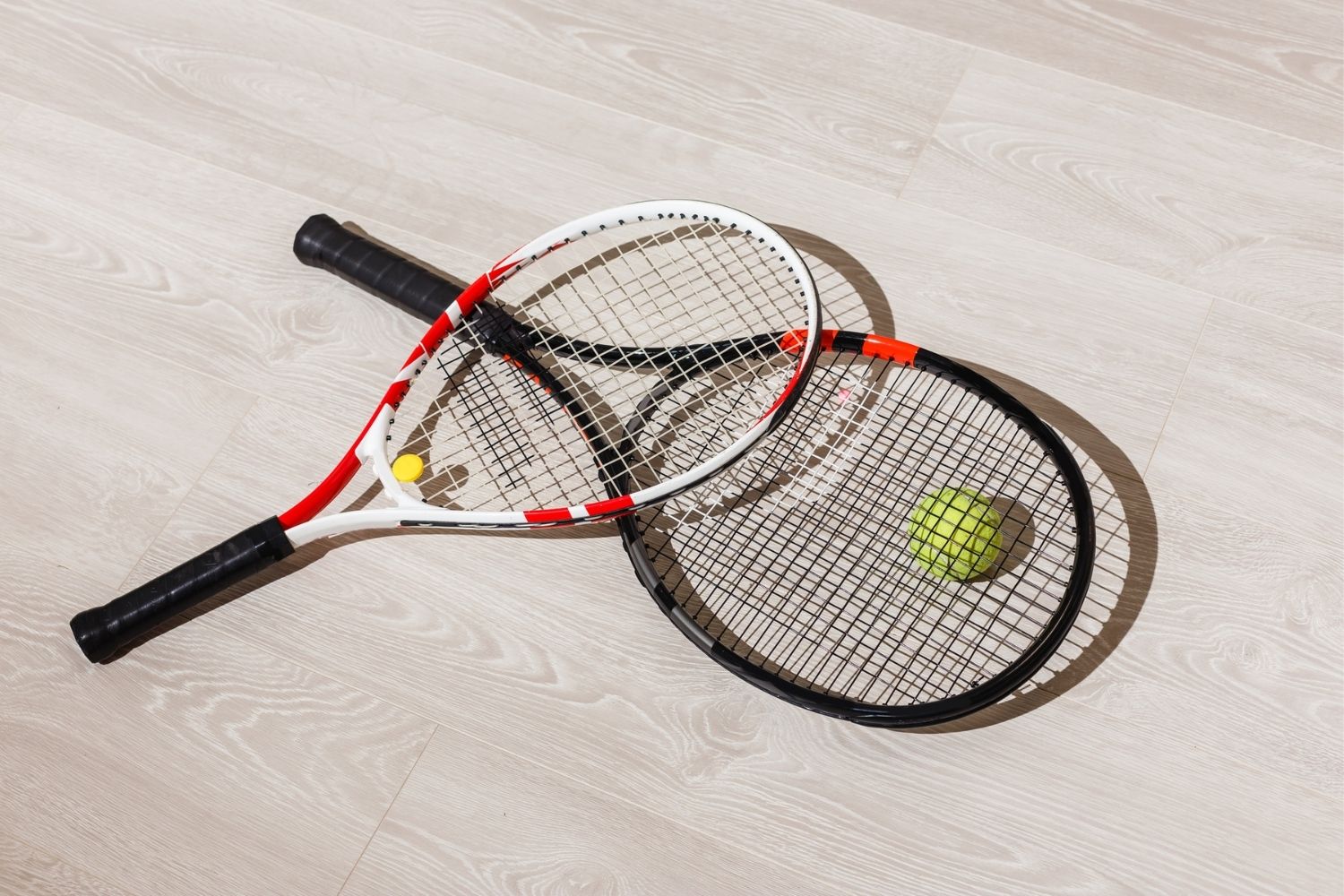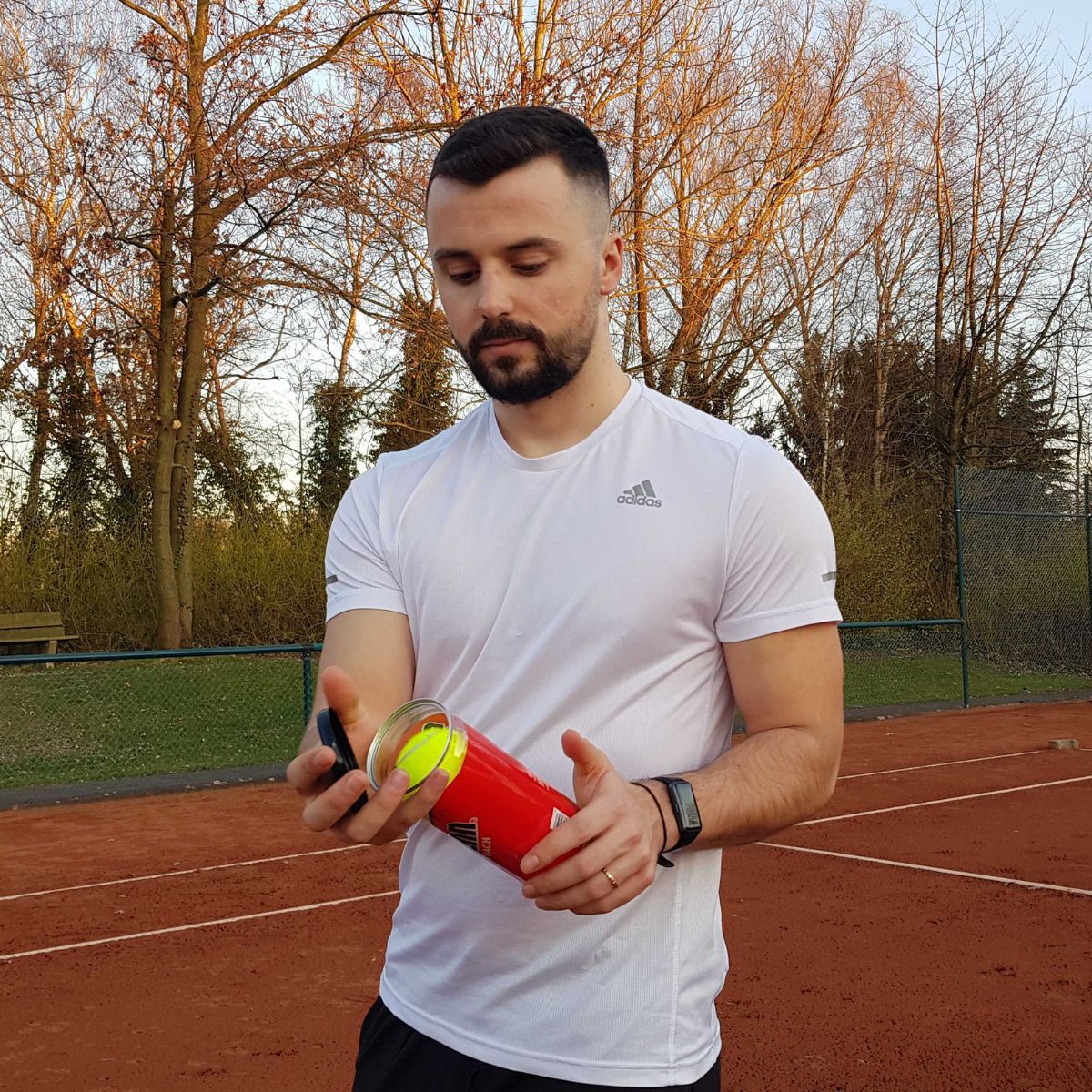- Tennis racket size is determined by the head size and length.
- Racket head size affects power, spin, and control.
- Racket length affects reach, power, spin, and maneuverability.
- Beginners should choose an oversized racket head for more margin of error. Intermediate and advanced players should choose a smaller head size for more control.
Ever wondered which is the suitable tennis racket size for you? You have come to the right place! The tennis racket is the most crucial component for a tennis player and a piece of equipment you should invest in wisely.
As a tennis player myself, I am aware of its importance, and I vividly remember my struggle back in the day to find the ideal tennis racket size that fit my age, playing style, and level.
So, to save you time and help make your journey in the tennis world as smooth as possible, I have put together all the information you will need on how to choose a tennis racket size. Together, we will go through tennis racket charts, the racket’s elements and how to choose the right size for all of them, and many more! Read along for all the details.
Tennis Racket Size Chart
If you want the answer behind “what size racket do I need,” it lies within its components: the tennis racket head, its size, and the tennis racket length.
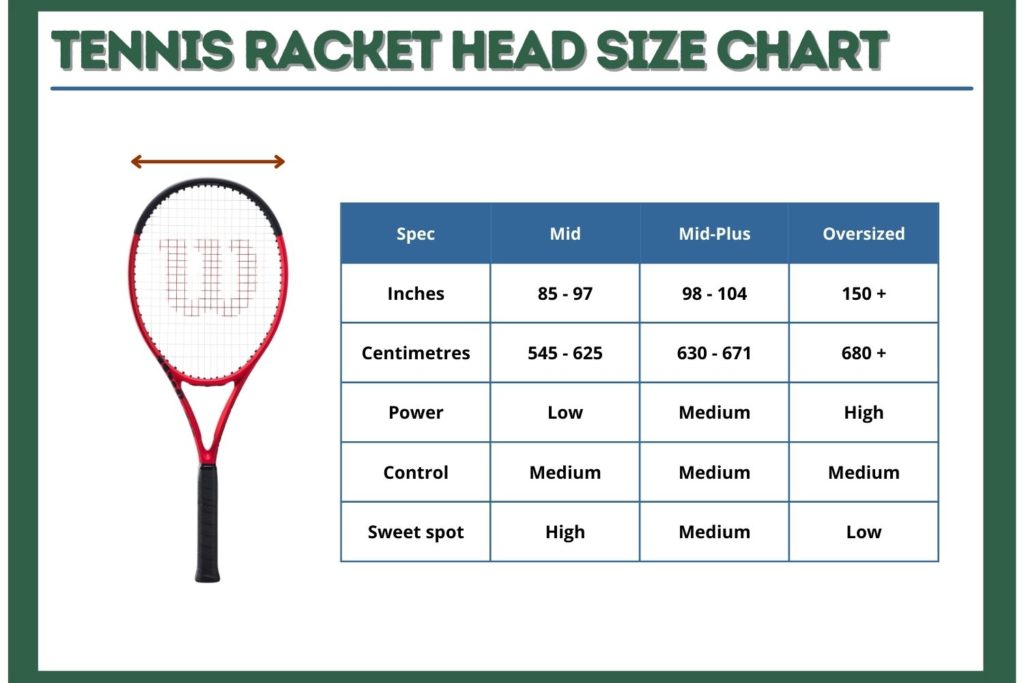
Head Size
Starting with the tennis racket head size, which represents the surface area of the stringbed. There are three racket heads sizes, each with specifications that will affect your performance as a player:
- Midsize – This tennis racket head size ranges from 85 to 97 inches² (548 – 626 cm²). This size is the smallest out of the three. Such a surface area offers less power generated from it but more control.
- Oversized – This tennis racket head size ranges from 105 inches² and above (677+ cm²). This size is the largest out of the three. It offers more power for the ball to bounce further but with limited control.
- Mid-plus size – This tennis racket head size ranges from 98 to 104 inches² (632 – 671 cm²). The mid-plus size is that “in-between” size that offers you the best of both worlds — a balance between power and control.
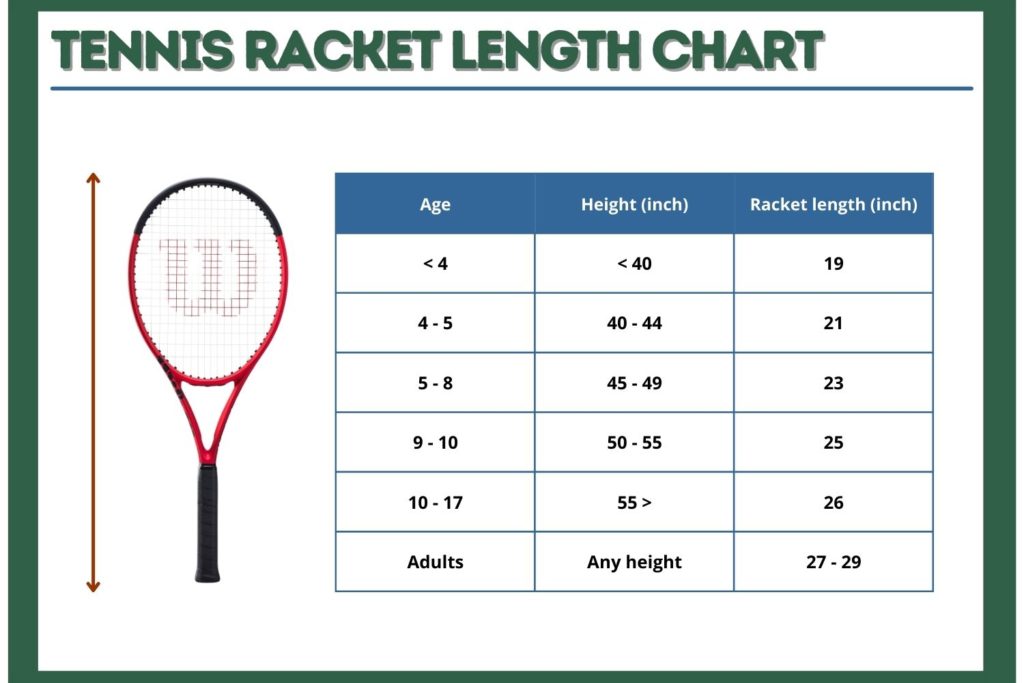
Length Size
Next, we have the racket’s length, which starts from the bottom of its handle up until the beginning of its head. The length ranges between 19 to 29 inches (48 – 74 cm), and each size is more suitable for specific age or height groups.
- Nineteen up until 23-inch rackets (approximately 48 to 58 cm) are ideal for children aged eight and below, with heights ranging from 3′ 75″ – 4 feet (approximately 114 – 124 cm) and below.
- 23 to 25-inch (58 – 63.5 cm) rackets are typically used by children aged 8-10 years old, with heights ranging from 4 feet to 4′ 6″ feet (124 – 140 cm).
- 26-inch (66 cm) rackets are common among teenagers with heights ranging from 4′ 6″ feet and taller (140 cm).
- 27 to 29-inch (68 to 73 cm) rackets are the typical tennis racket size length for adults (of any height).
Below I have compiled all of this information and more into a tennis racket size chart for the head classifications and one for the length ranges:
Racket Head Size: Why does it Matter?
The tennis racket head size is a decisive component of your performance as a player because that is where the ball will land on and the area from which you will strike it.
You must consider three main factors in terms of performance when choosing the right head size for you:
Surface Area
A larger surface area makes it easier to strike a ball without missing it. Especially if you are a beginner, it may be challenging to calculate where you should go and how to place your hand and racket so that you strike an incoming ball from your opponent.
The larger head size will provide less room for errors; even if you make a small miscalculation, you will have a higher chance of success in striking the ball regardless. On the other hand, smaller head sizes are more demanding precision-wise. Their margin for error (room for error) is less than larger sizes.
Another point to consider regarding the surface area is that larger ones have a more pronounced “sweet spot,” an area in the middle of the stringbed that helps reduce shockwaves during strokes for the players.

Power
Larger head sizes aid the player in generating more power during a hit than smaller head sizes. They are also less prone to error.
Larger head sizes (oversized ones) have a bigger surface area, which amounts to the ball sinking deeper into the stringbed and, thus, also bouncing further after the impact.
Even striking the tennis ball with barely any force will result in a more powerful stroke than you are used to with smaller head sizes.
However, larger head sizes have to sacrifice control for more power. On the contrary, you will have a better sense of control with a smaller head size, despite such rackets not giving you the upper hand for generating power.
Spin
Larger head sizes also serve as a spin generator/enhancer. We cause the ball to spin by striking the ball fast and steeply — our chance of achieving this type of stroke without missing increases in large surface areas.
Moreover, with the surface being larger, strings will be further apart, promoting spin. So, with a better chance of landing a strike and with the “open” strings in your favor, you will be sure to generate that spin you need.
Tennis racket string patterns also play a role in enhancing the spin.
Of course, there are various string patterns, with the most common one being the 16×19 pattern found in all head sizes. However, open patterns (where strings are placed farther apart), such as 16×9 or 16×8 patterns, generate more spin due to the ball sinking deeper into the stringbed.
In contrast, closed patterns like the 18×20 one, where the strings are closer, will not generate much spin. But your control when you strike will increase as the surface area making contact with the ball will be larger.
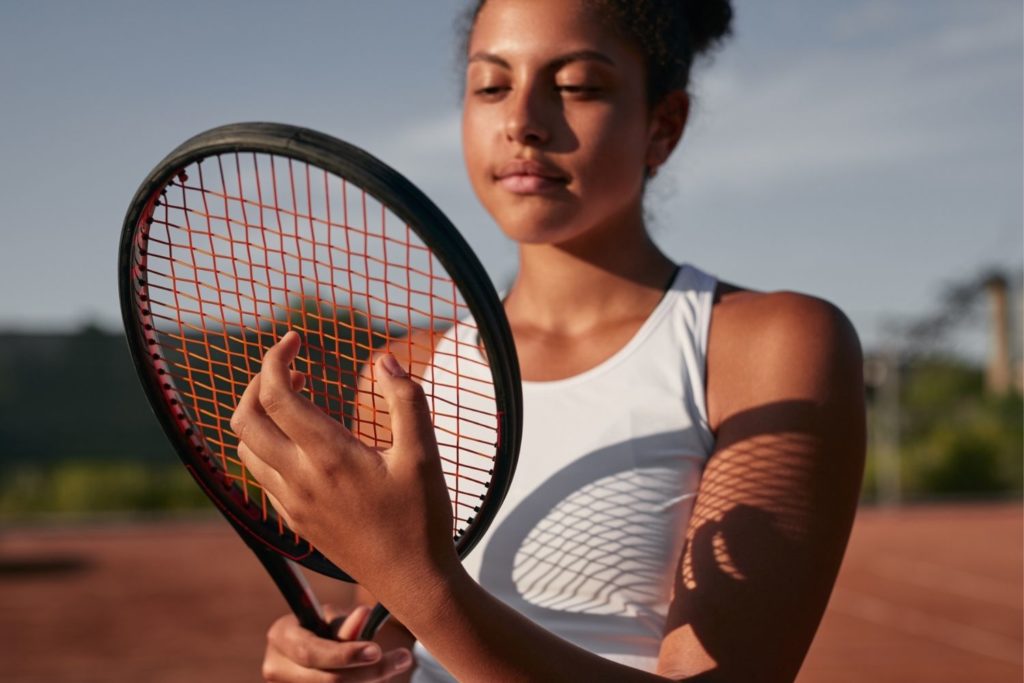
Choosing the Right Head Size
To choose the right tennis racket head size for you, it is important to first assess your experience level as a player.
Beginners
If you are a beginner player looking for the right beginner tennis racket head size, I got the answers you need.
As you might have concluded from the above explanations, oversized head sizes will be most useful to you. They will provide you with more margin for error, as miscalculations are bound to happen until you get the hang of it.
It is tough in the beginning to strike a ball efficiently with as much power as needed. So, oversized heads will assist you in generating the required amount of power.
However, if you feel that you are coordinated enough and want to learn and practice long swings, you might want to consider the smaller head sizes that will provide you with more control.
Intermediate and Advanced
If you are an intermediate or advanced player, you might want to consider buying a tennis racket with a smaller head size. At this point in your career (or hobby!), you should be looking for more control and less power and spin generated by your racket and more power and spin generated by you and your technique.
So, a midsize head (or mid-plus size if you are an intermediate player not comfortable with a really small head size yet) would be perfect for a feeling of control. And it will also help you further develop your technique and style as a player!
However, it is important to note for both beginners and more advanced players alike that your choice in the head size should all come down to preferences and what feels more comfortable to you. These are all tips and suggestions from my experience as a tennis player; nothing is set in stone!
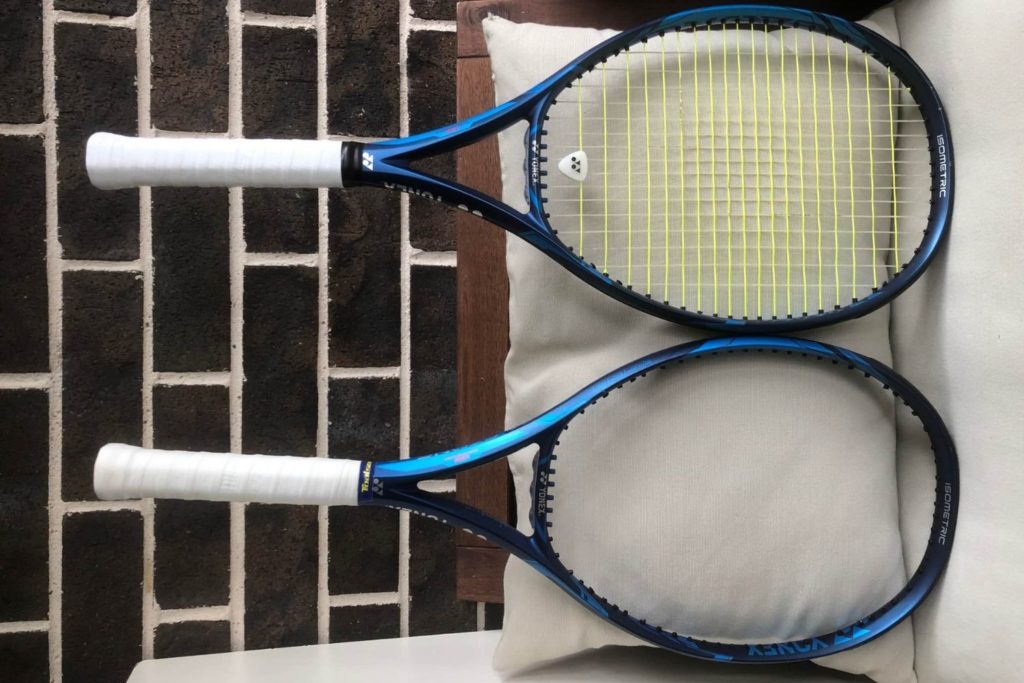
Pre-strung Vs. Unstrung Rackets
When you buy your new tennis racket will either be strung or unstrung, another significant detail to consider. But what exactly do these words refer to?
Well, already-strung rackets are ones with strings installed by their manufacturers. These types of tennis rackets are ideal for beginners or recreational players that do have barely or no experience putting the strings on by themselves.
On the other hand, unstrung rackets do not have the strings installed, and it is up to you to put everything together. Unstrung rackets are perfect for seasoned players that want to customize the strings according to their needs.
Racket Length: Why does it Matter?
The tennis racket length is the second component I will talk about. It is a crucial component as that is the part of the racket you will be holding on to during the game.
There are four main factors to consider when choosing the perfect length for yourself:

Reach
What is meant by reach is the capacity to strike a tennis ball far from your body/where you are standing, simply put.
So, if you have a longer racket, such as 27 to 29-inch ones, you will have more reach. On the contrary, choosing a racket length on a smaller range will limit your reach.
Power
Longer rackets generally provide the player with more power. Even if your swing is not too fast when striking, these rackets will make up for that and deliver a powerful stroke.
Typically, long rackets are perfect for serving. Due to their increased power, the serve will be faster and, thus, more challenging for the opponent to stop.
Spin
Just like power, with a longer racket, the ball’s spin will increase as well. Longer rackets are associated with increased head speed (the speed at which the racket’s head moves to and from the ball during a stroke).
Head speed is another crucial factor in achieving the spin, so as it increases, so does the spin.
Maneuverability
This factor goes hand in hand with reach. Maneuverability is all about how flexible you are in moving around your racket.
While a longer racket may aid in reaching further away from your body, these rackets are generally difficult to strike balls coming close or straight to your body.
Due to their length, such rackets are also difficult to maneuver when the ball is traveling at high speed, as it leaves you with barely any time to react.
Therefore, if you need to perform a stroke such as a volley or a return and have a long racket, you should work on sharpening your reflexes.

Choosing the Right Length and Grip Size
Tennis racket lengths are usually associated with age rather than your level as a player until you become an adult.
Kids
So, if you are looking for the right length for your child, as you may have noticed from the table in the picture above (the tennis racket length chart), you should choose:
- A 19-inch racket length if your child is four years old or younger.
- A 21-inch racket if your child is 4-5 years old.
- A 23-inch racket if your child is 6-8 years old.
- A 25-inch racket if your child is 9-10 years old.
- A 26-inch racket if your child is 10-17 years old. Although it may depend on their skill level and comfortability at this age, 16-17 year olds may switch to a 27-inch racket if they feel ready to use one.
As you can see, kids aged four and ten are included in more than one category, as the ideal racket length for them may also be affected by their construct and height.
After all, these ages are known for their sudden sprouts of growth! So, you may need to consider that they will be switching rackets until they reach the adult-size rackets.
Another tip on finding the best tennis racket size for your child is to use their size and the racket’s size as a reference instead. The steps you need to determine this are as follows:
- The child should stand up straight.
- Put the tennis racket next to their child, standing straight and with the handle upwards. (Note: You need to put the racket on their playing side, the left side if left-handed and the right side if right-handed)
- Check if your child can reach the handle and hold its tip with their fingers without needing to stretch towards it.
- If yes, then that’s the length that you need. If not, you should repeat the procedure until you have found the right one!
Adults
Tennis racket size for adults may be somewhat dependent on your technique and skill level to decide the ideal racket length.
I would recommend any beginner adult to start with a 27-inch racket. It is one of the standard sizes and arguably the most common size in the tennis racket market.
Being the most common size will give you numerous options regarding the rest of the criteria (head size, string pattern, grip) to decide on the one that makes you feel the most confident in your game.
Starting with a shorter size will give you time to adjust to it while learning the basics, and you may never even need to switch to a longer racket.
However, after improving and settling down on a playing style, you can switch to a longer racket, such as the 29-inch one (the maximum length allowed in official games). As I keep on saying, it all depends on your personal preferences!
As for your tennis racket grip size, you can follow the two methods below to find the perfect size. I would recommend combining the two for better and more accurate results.
- The ruler test – Put the fingers in the hand you use to grip the racket together. Next, place a ruler starting from the horizontal crease on the bottom of the hand. Measure the distance from there to the tip of your ring finger. The distance is your grip size!
- The index finger test – Grip the tennis racket with your hand. Put the index finger of your other hand in the space created between your ring finger and your palm. If it can’t fit or the space between your ring finger and palm is too big, it is not the right grip size. Otherwise, if it fits, that’s the right size for you!
Tennis Racket Size and Length Official Rules
Although I hope to have helped many of you in choosing the right tennis racket size to suit your needs, skill level, and technique, you must keep in mind that there are some official rules regarding tennis racket dimensions. These rules are of utmost importance if you are trying to become a competitive player or if you are one already.
But fear not, most of the tennis rackets you will find in the market fall into these range categories. So, it is highly unlikely for you to violate these measurement rules. However, it is wise to keep it in mind, nevertheless!
As I previously mentioned, this is the most common length you will find in markets, so it will be fairly easy to find one that matches the required length and fits your needs. These rules do not matter if you are only looking to play recreational tennis, so if that’s you, break the rules as you wish!
